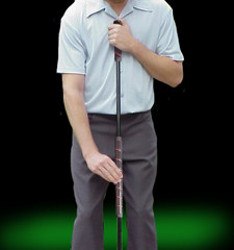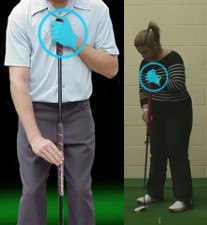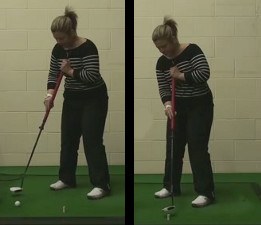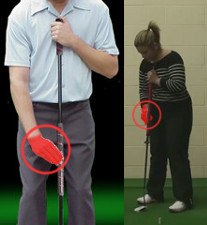- Stance: One key advantage of the long putter – it allows you to stand tall, not only alleviating back pressure but placing your eyes directly over or just inside the ball. This helps you see the line clearly and line up correctly. A long putter with a very vertical or upright lie angle (80° is the maximum allowed) will get you as close to the ball as possible.
- Left-hand grip: Most golfers rest the grip end against their sternum or elsewhere on the chest, though a few have held it against the chin. The left (top) hand is used to brace the club against the body by gripping it so the back of the hand faces outward.

- Right-hand grip: The right hand guides the club, so the grip is crucial. Many golfers use a conventional style, wrapping the palm and fingers around the handle. Another popular method is the so-called “claw” or “pencil” grip, with the fingers and thumb lightly pinching the club and the back of the hand facing outward. This style ensures the right hand and wrist remain passive during the stroke.
- Stroke: The left arm holds the putter steady as the right hand catalyzes a pendulum-like motion. The shoulders simply rock back and forth, just as they should in a traditional arms-and-shoulders stroke. The head, torso and legs are still.

As of this writing (April 2013), golf’s ruling bodies have merely proposed banning the anchoring of a putter to the body when making a stroke. Unless and until the practice is outlawed, it’s worth considering an elongated putter if you’re looking for help on the greens.
Adam Scott became the latest pro to claim a major title with an anchored putter, winning the 2013 Masters. Scott wields a so-called “long” putter, placing the end of the grip against his chest. Others, including 2012 Open Championship winner Ernie Els, prefer the “belly” or mid-length putter, a shorter version anchored against the midsection.
The concept is the same with both putters. Anchoring the butt end to the body stabilizes the stroke, minimizing (if not eliminating) movement of the putter away from and toward the golfer. Proponents—and opponents—of anchoring believe it’s a great way to combat nerves and the herky-jerky motion that plagues many players.
Proponents—and opponents—of anchoring believe it’s a great way to combat nerves and the herky-jerky motion that plagues many players.
Using either the long or belly putter is quite simple. Let’s start with long putters, typically measuring around 46-50”. (A standard-length putter is 35”.)
 The belly putter is typically employed using a conventional setup, grip and stroke. The main difference, of course, is that the end of the club is made stationary by pushing it into the body.
The belly putter is typically employed using a conventional setup, grip and stroke. The main difference, of course, is that the end of the club is made stationary by pushing it into the body.
It remains to be seen whether golf’s governing bodies will ban anchoring once and for all. If they do, many amateurs may choose to ignore the rule and keep right on anchoring, at least in non-tournament rounds. The method can make that much difference.







